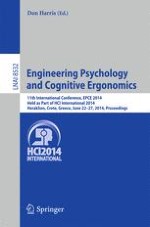This book constitutes the refereed proceedings of the 11th International Conference on Engineering Psychology and Cognitive Ergonomics, EPCE 2014, held as part of the 16th International Conference on Human-Computer Interaction, HCII 2014, held in Heraklion, Greece, in June 2014, jointly with 13 other thematically similar conferences. The total of 1476 papers and 220 posters presented at the HCII 2014 conferences were carefully reviewed and selected from 4766 submissions. These papers address the latest research and development efforts and highlight the human aspects of design and use of computing systems. The papers accepted for presentation thoroughly cover the entire field of human-computer interaction, addressing major advances in knowledge and effective use of computers in a variety of application areas. The total of 54 contributions included in the EPCE proceedings were carefully reviewed and selected for inclusion in this volume and are organized in the following topical sections: mental workload and stress; visual perception; cognitive issues in interaction and user experience; cognitive psychology in aviation and space; transport and industrial applications.
